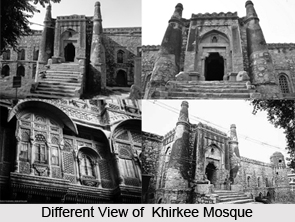 Khirkee Mosque, also called the Masjid of Windows, is an important ancient monument in Delhi. It is one of the only two examples of closed mosque in northern India. It is situated about two kilometers northeast of Qutab Minar in the southern center of Khirkee Village, just off the Press Enclave Center of Khirkee Village. Khirkee Mosque is said to be the only mosque in North India, which is mostly covered.
Khirkee Mosque, also called the Masjid of Windows, is an important ancient monument in Delhi. It is one of the only two examples of closed mosque in northern India. It is situated about two kilometers northeast of Qutab Minar in the southern center of Khirkee Village, just off the Press Enclave Center of Khirkee Village. Khirkee Mosque is said to be the only mosque in North India, which is mostly covered.
Etymology of Khirkee Mosque
There are distinctive window opening with jalis or tracery known as khirkee or latticed windows. Placed on the upper level of the Khirkee Mosque`s exterior wall, these jalis were carved stone shields. The Khirkee Mosque as well as the nearby village got its name from this feature. `Khirki` is an Urdu word that means "window" and hence it is also called "The Masjid of Windows".
History of Khirkee Mosque
The Khirkee Mosque of Delhi was built by Khan-i-Jahan, the prime minister of Feroz Shah Tughlaq of the Tughlaq Dynasty in the late 14th century. It is one of the seven mosques built by him.
Architecture of Khirkee Mosque
The Masjid is in a quadrangular shape and features an unusual fusion of Islamic and traditional Hindu architecture. Built on an elevated plinth with detritus stone, which was thickly plastered, the Khirkee Mosque is double storied and has a series of basement cells in the lower storey. All the four corners of the Khirkee Mosque of Delhi have imposing bastions making it look like a fort. There are dwindling minarets on all the three gateways, except the west, with the eastern gate is the main entrance. The southern gate is open for the visitors and the devotees.
The courtyard has pillars and is divided into 25 squares with five on each side. Each square is further divided into nine smaller squares. A cluster of nine small low domes made in the Tughlaq pattern covers the following larger squares - the center square of the courtyard with two on the corners, three on each side and one in the middle. The four diagonal squares are left uncovered, through which sunlight finds its way to the inner sanctum of the mosque. The remaining squares are covered with flat roofs. The mosque is partly covered and partly uncovered. It is said that since Khan-i-Jahan used the mosque for his private worship, it was designed like this to beat the intense heat of the region.



















